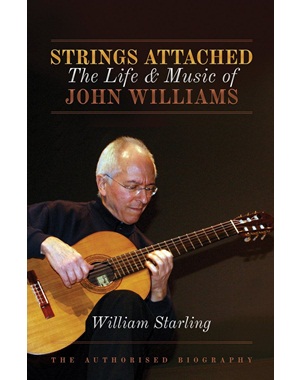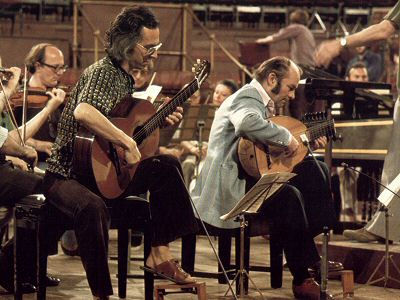 |
|
 |
 |
 |
|
|
In 1952, the family returned to England. Len wanted to set up a guitar school (which he did, with great success: The Spanish Guitar Centre continues his work today, under the guidance of Barry Mason). It's worth noting that Len Williams' later years were devoted to setting up the Looe Monkey Sanctuary in Cornwall: depending on whom you speak to, Len Williams is most famous for: being the father of a famous guitarist, establishing the London Guitar Centre, or his work with Woolly Monkeys. Few people can manage being famous for one thing in one lifetime, but for three? He also had an ulterior motive: recognising his young son's talent, he wanted him to study with the only the best teachers. This was not an option in Australia, and through a friendship with Terry Usher, they met Andres Segovia during a visit to London. The "creator of the modern classical guitar" was impressed with the 11-year-old and arranged for him to attend his summer school at the Accademia Musicale Chigiana di Siena in Italy. The young prodigy returned annually until 1959. The first of John Williams' successes came when, at the request of his fellow students, he received the unprecedented honour of giving the first complete solo recital by a student of any instrument in 1955. While not in Sienna, he attended the Royal College of Music in London from 1956 to 1959, where he studied piano and music theory. He didn't study guitar simply because, like most other musical colleges and conservatoires at that time, the RCM didn't provide a Guitar curriculum! Shortly after his graduation, however, he was invited to run the newly-created Guitar department. The College was evidently getting prepared for the onslaught of musicians who'd want to emulate their recent alumnus! He remained in the post until 1973, when his place was taken by his former student Carlos Bonnell. Williams has maintained a relationship with the College throughout the years and remains a Visiting Professor, including to the Royal Northern College of Music in Manchester. Stephen Dodgson, lecturer in Harmony at the College, was to continue a professional association with his erstwhile pupil for many years as arranger and advisor, and his Second Guitar Concerto was written in 1971 at Williams' commission, and is dedicated to him.
The programme mirrored the contents of his first two record albums, recorded at that time, and released in early 1959. He signed to the prestigious Ibbs & Tillett Agency (which later became part of the Harold Holt Organisation, now Askonas Holt), with whom he has remained throughout his career. Even then, he had a reputation to live up to, as the concert bill included the now famous quote (at least with regard to the first sentence) from Maestro Segovia: A prince of the guitar has arrived in the musical world. Of his performance, the London Times had to say: ... Already he has a remarkably well-developed technique; this was particularly evident in a transcription of three movements from a Bach cello suite, [No.3, trans. J.W. Duarte] where every detail was perfectly in place, and to his control he added most musical and stylish phrasing and tone-colouring. Nervousness may well have been responsible for a few over-stressed notes which obtruded from his otherwise shapely line in Weiss's well-known A-minor suite and inevitable artistic immaturity was no doubt the explanation of the unstylish rubato he frequently allowed himslf in Sor's Variations on a Theme of Mozart. [...] He is plainly an accomplished, serious-minded young artist whose future development can be watched with great interest.
His first UK appearance upon his return, again at the Wigmore Hall, was hailed as a major event, the Times stating: What has emerged first and foremost was the extent to which Mr Williams has strengthened his technique since we last heard him on this platform. He can now boast a very controlled agility, which served him admirably from viewpoints of rhythmic poise in a suite by Bach and and two sonatas by by Scarlatti. ... His concluding romantic group by Villa-Lobos, Turina, Ponce and Grandaos was also treated with sympathetic solicitude, but all this later music he still tends to interpret too inexpansively in terms of black and white instead of enjoying the flexibility and wider range of expressive colour for which it cries out. After two further successful recordings, 1963 saw his debut Japanese and North American tours, during which he was offered a recording contract with CBS Records (now Sony Classical), the first release, unimaginatively entitled CBS Presents John Williams, being issued in 1964. Williams has since averaged at least one new recording each year for the label, although some less classicallly-oriented repertoire has been issued by others. Until the mid-seventies, most recording sessions were conducted in New York, under the watchful eye of CBS Senior Producer Paul Myers. In 1964 he married for the first time, though this regrettably ended in divorce in 1969. His daughter Kate, born in 1965, is now a jazz pianist: see her own web site for further information. John Williams was one of several high-profile young classical solosists trying to make careers during the sixties, very much against the counter-culture norm for their peers. This group, including Isaac Perlman, Fou Ts'ong, Daniel Barenboim, Vladimir Ashekanzy, Jacqueline du Pré, all based in London, had a tendency to congregate both socially and professionally, to the extent that Williams and du Pré were the official witnesses at Fou Ts'ong's wedding (of course, Jacqueline and Daniel Barenbiom were themselves famously married by the end of the decade). One of the fruits of these friendships was John Williams' guest appearances on one of Jacqueline du Pré's first recordings in 1963, playing de Falla's Jota from Suite Española. Later collaborations included Daniel Barenboim conducting various orchestras in concerto performances, including on record, and an album of duets with Itzak Perlman. He also made appearances with Wilfred Brown (Tenor, also on record), the London String Quartet and other artists, and eventually took Julian Bream's place in frequent appearances with Alan Loveday (violin) and Amarylis Fleming (cello). He was already showing his preference for finding opportunities and repertoire to play with others, rather than solo recitals. John Williams has always spent a considerable amount of energy on expanding his repertoire beyond what Segovia had established, and an increasing interest in modern music led him to performing at the Premiere of Michael Tippett's King Priam in 1963, and later being involved in Pierre Boulez's ambitious recording of Anton Webern's entire oeuvre.
Julian Bream was an important person in John Williams' background as he was building his career. Eight years John's senior, Bream represented a different school of musical expression, and while Segovia was creating an audience for the "Spanish" guitar around the world, Bream focussed on creating a new repertoire, commissioning and playing new works by British classical composers (Berkeley, Bennett, Britten, Maxwell-Davies, Tippett, Walton, etc.). Williams, on the other hand, had always preferred to approach and absorb other strains of music, notably folk, jazz and even pop. (Personally, I find it telling that none of the major works Bream had created have ever formed part of Williams' repertoire). It was inevitable that the two men should meet professionally, one already the elder statesman (in his thirties!) and the other reluctantly wearing the prince's crown Segovia had conferred upon him. In Williams' own words, "although the way we each play is alike as chalk and cheese, we're not two musicians, we're an ensemble and we create magic together". Their appearances together, some recorded for television, were to continue throughout the seventies, culminating in their U.S. Tour in 1978.
|

 John Christopher Williams was born in Melbourne, Australia on 24th April 1941. His father,
John Christopher Williams was born in Melbourne, Australia on 24th April 1941. His father,  Williams made his professional debut at the Wigmore Hall in London on 6th November 1958, five months shy of his 18th birthday and completing his formal musical education.
Williams made his professional debut at the Wigmore Hall in London on 6th November 1958, five months shy of his 18th birthday and completing his formal musical education.
 Successful debuts followed in Paris (1959), Madrid (1961) and in 1962 he had the rare privilege for a Western musician to tour the Soviet Union. Wherever he played, he was greeted with adulation.
Successful debuts followed in Paris (1959), Madrid (1961) and in 1962 he had the rare privilege for a Western musician to tour the Soviet Union. Wherever he played, he was greeted with adulation.



